|
|
 |
|
Calanoida ( Order ) |
|
|
|
Clausocalanoidea ( Superfamily ) |
|
|
|
Scolecitrichidae ( Family ) |
|
|
|
Scottocalanus ( Genus ) |
|
|
| |
Scottocalanus persecans (Giesbrecht, 1895) (F,M) | |
| | | | | | | Syn.: | Scolecithrix persecans Giesbrecht, 1895 c (p.253, Descr.M, pl.3, figs.6-12:M); Giesbrecht & Schmeil, 1898 (p.48, Rem.M, fig.M); Cleve, 1904 a (p.197); Esterly, 1905 (p.166, figs.F,M); 1916 (p.171, 179: nutrition); van Breemen, 1908 a (p.80); ? Wolfenden, 1911 (p.251, Rem.); Esterly, 1912 (p.261 & suiv., 318);
? Scottocalanus persecans : Sars, 1925 (p.157, figs.F,M); Wilson, 1932 a (p.80, figs.F,M); Rose, 1933 a (p.143, figs.F,M); Brodsky, 1950 (1967) (p.241, figs.F,M) | | | | Ref.: | | | Farran, 1908 b (p.58, Rem.); A. Scott, 1909 (p.105, figs.M); ? Lysholm & Nordgaard, 1921 (p.22); ? Jespersen, 1940 (p.35); ? Lysholm & al., 1945 (p.26); ? Sewell, 1947 (p.143); ? Moore, 1949 (p.49); ? Tanaka, 1961 a (p.140, Rem.); Vervoort, 1965 (p.38, figs.F,M, p.43: Rem.); Owre & Foyo, 1967 (p.63, figs.F,M); Bradford, 1972 (p.32, figs.F); Gardner & Szabo, 1982 (p.274, figs.F,M); Park, 1983 (p.198, 200); Bradford & al., 1983 (p.116); Mulyadi, 1998 a (p.389, Redescr.M, figs.M); Mulyadi, 2004 (p.30, figs.M, Rem.); Vives & Shmeleva, 2007 (p.810, figs.F, M, Rem.) | 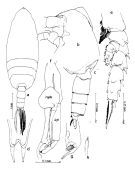 issued from : Mulyadi in The Raffles Bull. Zool., 1998, 46 (2). [p.388, Fig.5]. Male: a, habitus (dorsal); b, forehead (left lateral side); c, distal part of the last thoracic segment and urosome (left lateral side); d, rostrum (frontal view); e, P3; f, P5; g, apex of right distal segment; h, apex of left P5
|
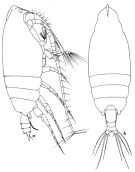 Issued from : W. Vervoort in Atlantide Report, 1965, 8. [p.39, Fig.3] Female (from off Liberia): a, habitus (lateral right side); b, idem (dorsal). Nota: The urosomal segments and furca in the proportional lengths 45:18:16:5:16 = 100. A1 24-segmented (segments 8 and 9 fused). The sructure of A2 and the oral appendages compared with that of S. helenae does not reveal differences.
|
 Issued from : W. Vervoort in Atlantide Report, 1965, 8. [p.40, Fig.4] Female: a, forehead (lateral); b, posterior part cephalothorax and urosome (dorsal); c, idem (lateral right side); d, rostrum (ventral view); e, P5. Nota: There are a slight difference in the shape of the crest (in lateral aspect) between this species and S. helenae. The rostral plate is just as in S. helenae, with the V-shaped incision reacing halfway the length of the plate; the rostral filaments are long and soft, slightly longer than the depth of the incision of the rostral plate, they are slightly bifid at the apex. Flat, hyaline spinules occur along the distal borders of the genital complex and the 3rd abdominal somite. Caudal rami as long as broad, and externally haired; there are 4 marginal setae, the appendicular (internal) seta is small and densely plumose. Anal somite almost completely telescoped into the 4th, the small, rounded anal plate is just visible.
|
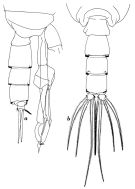 Issued from : W. Vervoort in Atlantide Report, 1965, 8. [p.42, Fig.5] Male: a, posterior part cephalothorax with P5 and urosome (lateral right side); b, idem (dorsal). Nota: Proportional lengths of cephalothorax and urosome 21:8. Proportional lengths of urosomal somites and caudal rami 22:24:20:23:4:7 = 100. Genital somite asymmetrical, genital opening on the left side.
|
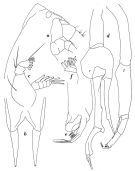 Issued from : W. Vervoort in Atlantide Report, 1965, 8. [p.44, Fig.6] Male: forehead (lateral); b, rostrum (ventral view); c, Md (mandibular palp); d, P5 (l = left leg; r = right leg); e, apex of left P5; f, endopodite of Mx2.
|
 Issued from : G.O. Sars in Résult. Camp. Scient. Prince Albert I, 69, pls.1-127 (1924). [Pl.XLIV, figs.1-19]. With doubt. Between Gibraltar, Canary Islands and Azores. Female: 1, habitus (dorsal); 2, idem (lateral left side); 3, forehead (lateral); 4, rostrum (frontal view); 5, A2; 6, Md; 7, Mx1; 7, Mx2; 8, Mxp; 9, distal segment of Mx2; 10, Mxp; 11, P1; 12, P2; 13, P3; 14, P4; 15, P5; 16, idem, with intercoxal plate (ventral view). Male: 17, habitus (lateral left side); 18, P5; 19, terminal part of left P5 (enlarged). Female :
- Forehead sallent in dorsal view and with triangular crest. - Cephalosome and pediger 1 fused, pedigers 4 and 5 fused. - Rostrum strong, bifurcate, ending by 2 points. - eye distinctly visible, having on the surface some irregular facets. - Posterior corner of the last thoracic segment rounded a little blunted. - Urosome short about ¼ length of prosome. - Genital segment as long as the two suceeding segments together ; slightly swollen ventrally. - Anal segment very short, scarcely visible. - Caudal rami short and well separated each other ; each ramus bearing 4 plumose setae plus on the inner angle a little simple , short seta. - A1 24-segmented with short setae, reaching the anal segment. - A2 exopod more longer than endopod. - Md relatively strong, gnathobase well developed with a salient angle in the middle. Two teeth are comparativement short and thick, following at inner angle by a curved seta. - Mx1 resemble those of Phaennidae. - Mx2 weak ; terminal part bearing 8 vermiform elements, simple or ending by a button. - Mxp normal, with segment proximal slightly stretched and medial slightly widen, medial strechted, and 5 terminal segments. The setae are thin and of moderate length. - P1 exopod 3-segmented ; endopod 1-segmented - P2 exopod 3-segmented ; endopod 2-segmented with distal segment bearing on the posterior surface 6 little spines in 3 successive rows ; the 1st endopodal segment curved outward on the distal. - P3 endopod bearing of some spinules. - P4 endopod witout spinules. - P5 small, imperfectly 3-segmented, terminal segment partly fused to preceding, outer side stretched and slient, hatchet-like ; bearing at extremity, inside, a very long spine reaching the end of the genital segment.
Male : Body of general structure as in female. - Urosome 5-segmented , the first short and slightly asymmetrical . - A1 reaching the middle of urosome ; sensoriel organs more developed than in female.. - Mouthparts as in female. - P5 strongly developed reaching the end of the urosome. ; distinctly asymmetrical, but opposite to Phaennidae, the right leg is the greatest and more complicated of the two legs. Basal distal segment is noteworthy strechted, almost circular-shape, the two rami well developed, though different srructure. Exopod bearing a distal curved claws having peculiar appearence : at the base, inside, a conical salient and at the obtuse extremity a little lanceolate appendage. Endopod ending point, slightly incurved and passing beyond slightly the claws. Left leg with 2 basal segments strechted and very long. Endopod little and simple ; exopod well developed consisting distinctly of 2 segments, distal segment having inside 2 tuberculiform spurts, anda t the tip 2 curved setae, juxtaposed together coming out from a little bud.
|
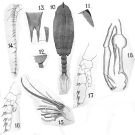 issued from : A. Scott in Siboga-Expedition, 1909, XIX a. [Plate XXVII, Figs.10-18]. Male (from Celebes Sea and Halmahera Sea): 10, habitus (dorsal); 11, forehead (lateral); 12, last thoracic and genital segments (left side); 13, rostrum; 14, A1; 15, Mx2 (distal portion); 16, P2; 17, P4; 18, P5.
|
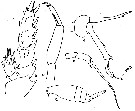 issued from : C.O. Esterly in Univ. Calif. Publs Zool., 1905, 2 (4). [p.166, Fig.28]. As Scolecithrix persecans. Female (from San Diego Region): e, P5. Nota: A1 23-segmented, reaching to end of caudal rami. Mouthparts and swimming legs as in the male. Male: a, habitus (lateral); b, P2; c, left P5; d, right P5 (re.3 = 3rdsegment of exopod). Nota: Last two thoracic segments fused. Left A1 18-segmented, right 17-segmented, reaching beyond cephalothorax. Exopod of A2 at least 1 1/4 times as long as endopod. 2nd basal of Mx1 with 5, exopod with 8, endopod with 7 bristles.
|
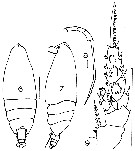 issued from : J.M. Bradford in Mem. N. Z. Oceonogr. Inst., 1972, 54. [p.42, Fig.9, (6-9)]. Female (from Kaikoura, New Zealand): 6-7, habitus (dorsal and lateral, respectively); 8, P5; 9, P2. Scale bars: 1 mm (6, 7, 9); 0.1 mm (8). First record from New Zealand waters.
|
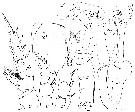 issued from : W. Giesbrecht in Bull. Mus. comp. Zool. Harv., 25 (12). [Taf. III, Figs.6-12]. Male (from 35°N, 125°W): 6, P2; 7, P1; 8, exopod of P3; 9, urosome (lateral, right side); 10, forehead (lateral); 11, A2 (without setae); 12, P5.
|
 issued from : H.B. Owre & M. Foyo in Fauna Caribaea, 1, Crustacea, 1: Copepoda. Copepods of the Florida Current. [p.62, Figs.398, 399, 406]. Female: 398, habitus (lateral); 406, rostrum. Nota: Terminal projections of the bifurcated rostrum longer than the depth of the rostral excavation; each projection in itself bifurcated. Male: 399, rostrum.
|
 issued from : H.B. Owre & M. Foyo in Fauna Caribaea, 1, Crustacea, 1: Copepoda. Copepods of the Florida Current. [p.62, Figs.407, 408]. Female: 407, P5. Male: 408, P5.
| | | | | Compl. Ref.: | | | Sewell, 1948 (part., p.329, 502, 519, 521, 532, 546, 557); C.B. Wilson, 1950 (p.340); Østvedt, 1955 (p.15: Table 3, p.69); Grice, 1963 a (p.495); Ahlstrom & Thrailkill, 1963 (p.57, Table 5, abundance); De Decker & Mombeck, 1964 (p.14); Grice & Hulsemann, 1965 (p.224); Fleminger, 1967 a (tabl.1); Park, 1970 (p.476); Lee & al., 1971 (p.1150); Bainbridge, 1972 (p.61, Appendix Table III: occurrence); Björnberg, 1973 (p.333, 389); Vives & al., 1975 (p.43, tab.II, XII); Carter, 1977 (1978) (p.35); Dessier, 1979 (p.205); Guangshan & Honglin, 1984 (p.118, tab.); Brenning, 1984 (p.4, Rem.); Tremblay & Anderson, 1984 (p.6, Rem.); Brenning, 1985 a (p.28, Table 2); Rudyakov, 1986 (tab.1); Lozano Soldevilla & al., 1988 (p.59); Suarez & al., 1990 (tab.2); Shih & Marhue, 1991 (tab.3); Suarez & Gasca, 1991 (tab.2); Suarez, 1992 (App.1); Gopalakrishnan & Balachandran, 1992 (p.167, fig.7, Table 1, 2); Shih & Young, 1995 (p.74); Suarez-Morales & Gasca, 1998 a (p.111); Holmes, 2001 (p.60); Sameoto & al., 2002 (p.13); Beaugrand & al., 2002 (p.179, figs.5, 6); Lo & al., 2004 (p.89, tab.1); Gaard & al., 2008 (p.59, Table1, N Atlantic Mid-Ridge); Galbraith, 2009 (pers. comm.); in CalCOFI regional list (MDO, Nov. 2013; M. Ohman, comm. pers.); Sano & al., 2013 (p.11, Table 9, food habits) ; Lidvanov & al., 2013 (p.290, Table 2, % composition); El Arraj & al., 2017 (p.272, table 2); | | | | NZ: | 17 | | |
|
Distribution map of Scottocalanus persecans by geographical zones
|
| | | | | | | | | | Loc: | | | South Africa (E), off E Tristan da Cunha, Namibia, Congo, G. of Guinea, off Lagos, Cape Verde Is., Mauritania (off Cap Blanc), Canary Is., Morocco, Ibero-moroccan Bay, Portugal, Azores, off Amazon, Caribbean, G. of Mexico, Florida, Bermuda, Woods Hole, off E Nova Scotia, S Iceland, off W Ireland, Norwegian Sea, off Madagascar, Nosy Bé, Natal, ? Arabian Sea, Indonesia-Malaysia, Flores Sea, Macassar Strait, Celebes Sea, Halmahera Sea, Philippines, China Seas (East China Sea, South China Sea), Taiwan (N: Mienhua Canyon), Pacif. (W equatorial), New Zealand (Kaikoura), Pacif. (N), British Columbia, California, San Diego, W Baja California, off Galapagos, Peru, Chile | | | | N: | 64 | | | | Lg.: | | | (1) F: 4,8; (5) M: 4,4; (16) F: 4,45-3,9; M: 4,65-4,3; (22) F: 4,8-5,76; M: 4,8; (47) M: 4,5; (116) F: 4,8; (142) F: 4,6; M: 5,3; (777) M: 4,65; (1111) M: 4,0; 4,1; (1122) M: 4,65; {F: 3,90-5,76; M: 4,00-5,30} | | | | Rem.: | Bathypelagic.
For Sars (1925, p.160) , this species is the same that the one indicated by Giesbrecht in the Pacific Ocean as Scilecithrix persecans. With doubts of the identity and gives to this species a new name: S. thorii, that is a mistake
For Østvedt (1955) it is probably only an exceptional circumstance that this species penetrates as far into the Norwegian Sea as latitude 66° N.
According to Vervoort (1965, p.45) , the species represents a regular inhabitant of the tropical Atlantic and Pacific, occurring at intermediate depths, penetrating surface waters during the night.
Certain males and females ascribed to this species may be mistaken, because of the general resemblance with S. helenae, hence a questionable geographical distribution (cf. in Vervoort, 1965, p.43).
According to Brodsky (1967, p.242) a comparison of the drawings suggests that the Atlantic specimens, particularly those described by Sars (from Azores) should be belong to another species. | | | Last update : 25/10/2022 | |
|
|
 Any use of this site for a publication will be mentioned with the following reference : Any use of this site for a publication will be mentioned with the following reference :
Razouls C., Desreumaux N., Kouwenberg J. and de Bovée F., 2005-2024. - Biodiversity of Marine Planktonic Copepods (morphology, geographical distribution and biological data). Sorbonne University, CNRS. Available at http://copepodes.obs-banyuls.fr/en [Accessed April 27, 2024] © copyright 2005-2024 Sorbonne University, CNRS
|
|
 |
 |















